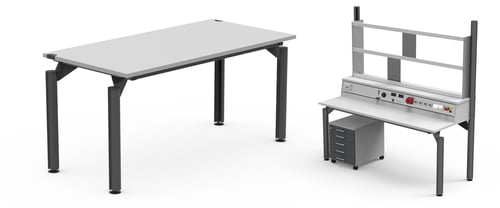6 min read
Lean Six Sigma: Beginner’s Guide to Six Sigma Certification
![]() Jens Walter
:
06.Februar.2025
Jens Walter
:
06.Februar.2025
In today’s competitive market, businesses are constantly searching for ways to improve quality, reduce costs, and streamline processes. Six Sigma has become a powerful methodology that organizations across industries use to achieve these goals. If you’re new to Six Sigma and want to understand what it’s all about, this guide will take you through the essentials. Let’s explore how Lean Six Sigma can be a game-changer for your business and the key concepts you need to know to get started.
What is Lean Six Sigma?
Six Sigma is a data-driven methodology focused on improving quality and eliminating defects in business processes. Originally developed by Motorola in the 1980s, Six Sigma gained widespread popularity after being adopted by companies like General Electric. The six sigma’s goal is to ensure processes are 99.99966% defect-free, which translates to only 3.4 defects per million opportunities.

Why is Six Sigma Important?
By improving quality and efficiency, Six Sigma can significantly reduce costs and increase customer satisfaction. In industries where precision is crucial, Six Sigma’s structured approach to problem-solving helps businesses avoid costly errors, minimize waste, and optimize workflows. Implementing Six Sigma and investing in Six Sigma professional training can lead to:
- Reduced operational costs
- Higher customer satisfaction
- Increased profitability
- Enhanced competitive advantage
With Six Sigma training, employees gain valuable skills that allow them to identify inefficiencies and implement process improvements, further supporting a culture of continuous improvement.
Key Concepts of Six Sigma
Here are some fundamental principles of Six Sigma that you should know:
-
DMAIC Process: The cornerstone of Six Sigma is the DMAIC process, which stands for Define, Measure, Analyze, Improve, and Control. This five-step approach provides a systematic way to identify issues, measure their impact, find root causes, implement solutions, and maintain improvements over time.
-
Defects and Variation: Six Sigma is based on minimizing defects in a process. A defect is any outcome that doesn’t meet customer expectations, while variation refers to the inconsistencies that lead to defects. Reducing variation is key to achieving high levels of quality and reliability.
-
Sigma Levels: Sigma levels are measures of process capability. A Six Sigma process (6σ) is nearly perfect, with only 3.4 defects per million opportunities. Lower sigma levels indicate a greater likelihood of defects. The higher the sigma level, the better the process performance.
-
The Role of Data: Six Sigma relies heavily on statistical analysis and data-driven decision-making. By collecting and analyzing data, Six Sigma teams can gain insights into the causes of defects and variation, which enables them to implement effective solutions.
-
Continuous Improvement: Six Sigma is not a one-time solution but a commitment to ongoing improvement. It encourages businesses to continuously assess and refine their processes to sustain improvements and adapt to changing needs.
Roles within Six Sigma
Six Sigma uses a belt-based hierarchy to define roles within a project:
- Six Sigma Yellow Belt: Entry-level team members who have a basic understanding of Six Sigma concepts.
- Six Sigma Green Belt: Team members who work on Six Sigma projects and apply DMAIC under the supervision of Black Belts.
- Six Sigma Black Belt: Leaders who manage Six Sigma projects, guiding teams through DMAIC and ensuring proper application of Six Sigma tools.
- Six Sigma Master Black Belt: Experts who mentor Black Belts and provide strategic guidance across the organization.
- Champion: Senior leaders who oversee Six Sigma deployment and ensure alignment with business objectives.
Benefits of Six Sigma
The implementation of Six Sigma program has led to transformative results for countless organizations. Some benefits include:
.png?width=777&height=777&name=Benefits%20of%20Six%20Sigma%20(2).png)
- Reduced Costs: By eliminating waste and reducing defects, Six Sigma lowers operational costs.
- Enhanced Efficiency: With improved processes, businesses can streamline workflows, leading to faster turnaround times.
- Improved Quality: Six Sigma quality minimizes defects, resulting in higher-quality products and services.
- Increased Customer Satisfaction: Reliable and consistent quality enhances customer trust and loyalty.
- Employee Engagement: Six Sigma promotes a culture of accountability, encouraging employees to identify and solve issues collaboratively.
Getting Started with Six Sigma Certification
Six Sigma training and certification is a structured approach to improving business processes through the use of statistical analysis. There are different levels of certification includes training program , each corresponding to a "belt" color, much like martial arts. The levels range from basic to advanced, with each representing a deeper understanding and learning Six Sigma principles and tools. Here’s a breakdown of the Six Sigma belts:
.png?width=776&height=776&name=Benefits%20of%20Six%20Sigma%20(3).png)
1. Six Sigma White Belt (Beginner)
- Description: The White Belt training is the entry-level white belt certification, introducing basic Six Sigma concepts and tools. It covers the fundamentals of process improvement.
- Focus: Basic understanding of 6 Sigma methodologies, key terms, and principles.
2. Six Sigma Yellow Belt (Beginner/Intermediate)
- Description: The Yellow Belt is an introductory level that provides a deeper understanding of Six Sigma and its application within an organization.
- Focus: Understanding of the DMAIC (Define, Measure, Analyze, Improve, Control) methodology, contributing to process improvement teams, and understanding how data is used in decision-making.
3. Six Sigma Green Belt (Intermediate)
- Description: Lean Six Sigma Green Belt certification focuses on individuals who are involved in Six Sigma projects part-time. Green Belts lead smaller projects and assist Black Belts with larger projects.
- Focus: Understanding of advanced statistical analysis, process improvement tools, and managing projects using DMAIC.
4. Six Sigma Black Belt (Advanced)
- Description: Black Belts lead larger, more complex Six Sigma projects and train and mentor Green Belts and Yellow Belts. This is a full-time role for those with extensive knowledge of Six Sigma and get six sigma black belt certification.
- Focus: Advanced statistical methods, project management, leadership, and mentoring skills. They drive process improvements and resolve complex problems.
5. Six Sigma Master Black Belt (Expert)
- Description: Master Black Belts Certification are experts in Six Sigma methodology. They provide strategic direction and mentoring across multiple projects and organizations.
- Focus: In-depth expertise in Six Sigma principles, data analysis, mentoring Black Belts, driving the cultural shift toward Six Sigma, and influencing organizational change.
6. Champion
- Description: While not a formal certification, Champions are high-level executives who support Six Sigma initiatives and ensure alignment with strategic goals. They act as sponsors for Six Sigma projects.
- Focus: Overseeing Six Sigma projects at a strategic level, ensuring resources, and aligning projects with company goals.
Key Differences Between the Belts:
- White Belt: Basic understanding
- Yellow Belt: Entry-level project involvement
- Green Belt: Leads smaller projects and supports larger ones
- Black Belt: Leads major projects full-time
- Master Black Belt: Provides advanced expertise and strategic guidance
.png?width=273&height=386&name=Six%20Sigma%20Overview%20Guide%20A%20One-Page%20Summary%20Executive%20Summary%20(2).png)
DOWNLOAD FOR FREE NOW!
Six Sigma Overview:
A Quick Guide
Ready to kickstart your first Six Sigma project? Download this handy Quick Guide Template for starting your first Six Sigma project.
Download for freeSix Sigma Overview:
A Quick Guide
After you have filled out and sent the form, you will receive the checklist immediately by e-mail.
Six Sigma Tools to Know
Six Sigma provides a range of tools to analyze and improve processes. Some of the most common include:
- Pareto Charts: A bar chart that helps identify the most significant factors contributing to a problem.
- Fishbone Diagram: Also known as the cause-and-effect or Ishikawa diagram, it helps identify root causes.
- Control Charts: These help track process performance and identify trends or variations over time.
- Failure Mode and Effects Analysis (FMEA): A method to proactively identify potential failures and prioritize improvements.
- 5 Whys Analysis: A simple but effective way to get to the root cause of an issue by asking "why" five times.
Enhancing Six Sigma with BeeWaTec: Workspaces for Quality and Efficiency
BeeWaTec’s solutions align closely with Six Sigma principles by providing products that enhance efficiency, reduce waste, and support continuous improvement in production environments. Here’s how BeeWaTec can be particularly useful for six sigma implementation in various operational settings:

1. Optimizing Workspaces to Minimize Defects
- Customized Workstations: BeeWaTec offers modular, adaptable workstations that can be customized to suit specific processes. This customization ensures that tools and materials are arranged ergonomically and efficiently, reducing errors caused by awkward or inefficient layouts.
- Error-Proofing with Visual Management: Many of BeeWaTec's workstation solutions integrate visual management elements. Visual aids and labels help operators work consistently and avoid mistakes, a key aspect of Six Sigma's focus on reducing defects.
2. Supporting Lean and 5S Methodologies
- Modular Systems for Flexibility: BeeWaTec's modular solutions allow for flexible layouts that can be easily reconfigured. This adaptability is ideal for the continuous improvement aspect of Six Sigma, allowing workspaces to be quickly adjusted as processes evolve and improve.
- 5S Organization Tools: Six Sigma encourages a clean, organized workspace, and BeeWaTec’s products are compatible with the 5S principles — Sort, Set in order, Shine, Standardize, Sustain — which help eliminate inefficiencies and optimize workflows. Many companies already included a sixth S, standing for safety. (Read more about it in our blog article regarding 6S >)
3. Reducing Variation through Standardized Workstations
- Consistent Workflows: By using standardized components, BeeWaTec helps create workstations that allow employees to work consistently by improving the material flow. Consistency in workflow is crucial for Six Sigma, as it reduces process variation and helps achieve a high level of product quality.
- Ergonomic Solutions for Improved Quality: Ergonomically designed workstations reduce physical strain on employees, which can lead to fewer errors and higher productivity. This supports Six Sigma's focus on achieving quality by ensuring that processes are reliable and consistent.
4. Facilitating Data Collection and Process Monitoring
- Visual Management and Data Tracking: BeeWaTec's systems can integrate data collection tools that provide real-time feedback on performance, helping identify trends and areas of improvement. This aligns with the Six Sigma DMAIC process, especially the "Measure" and "Analyze" phases.
- Easy Identification of Bottlenecks and Waste: Visual indicators and adaptable layouts allow teams to easily identify bottlenecks or sources of waste, which can then be addressed through Six Sigma’s problem-solving techniques.
5. Empowering Continuous Improvement and Employee Engagement
- Involvement in Workspace Design: BeeWaTec’s modular systems allow employees to participate in designing their workspaces, fostering engagement and encouraging suggestions for ongoing improvements. Six Sigma benefits greatly from engaged employees who are invested in process quality.
- Adaptable Systems for Ongoing Improvements: As processes evolve, BeeWaTec’s modular setups make it easy to implement incremental improvements, supporting the Six Sigma focus on continuous improvement.
Conclusion
Six Sigma is a powerful tool for improving quality, efficiency, and customer satisfaction. BeeWaTec's solutions further enhance Six Sigma practices by optimizing workspaces for lean operations and continuous improvement. By integrating BeeWaTec’s modular systems, businesses can reduce defects, streamline workflows, and foster a culture of quality and collaboration, driving sustainable results.
Start with Six Sigma to get a lean production
With our modular system you can implement any solution you need. Discover your possibilities, existing solutions or build your own material flow system with lean six sigma.




_Web_01_01.jpg?width=1240&name=Beewatec-3-(37)_Web_01_01.jpg)


